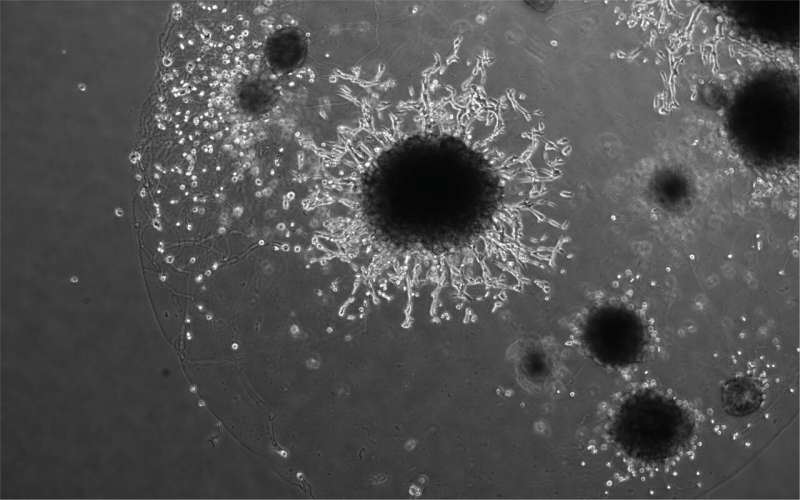This article has been reviewed according to Science X's editorial process and policies. Editors have highlighted the following attributes while ensuring the content's credibility:
fact-checked
peer-reviewed publication
trusted source
proofread
'Mini-placentas' help scientists understand the causes of pre-eclampsia and pregnancy disorders

Scientists have grown 'mini-placentas' in the lab and used them to shed light on how the placenta develops and interacts with the inner lining of the womb—findings that could help scientists better understand and, in future, potentially treat pre-eclampsia.
The study, published in Cell Stem Cell, shows that it is possible to experiment on a developing human placenta, rather than merely observe specimens, in order to study major disorders of pregnancy.
Successful pregnancy depends on the development of the placenta in the first few weeks of gestation. During this period, the placenta implants itself into the endometrium—the mucosal lining of the mother's uterus.
Interactions between the cells of the endometrium and the cells of the placenta are critical to whether a pregnancy is successful. In particular, these interactions are essential to increase the maternal blood supply to the placenta, necessary for fetal growth and development.
When these interactions do not work properly, they can lead to complications, such as pre-eclampsia, a condition that causes high blood pressure during pregnancy. Pre-eclampsia occurs in around six in 100 first pregnancies and can put at risk the health of both the mother and the baby.
Professor Ashley Moffett from the Department of Pathology at the University of Cambridge said, "Most of the major disorders of pregnancy—pre-eclampsia, still birth, growth restriction, for example—depend on failings in the way the placenta develops in the first few weeks. This is a process that is incredibly difficult to study—the period after implantation, when the placenta embeds itself into the endometrium, is often described as a 'black box of human development."
"Over the past few years, many scientists—including several at Cambridge—have developed embryo-like models to help us understand early pre-implantation development. But further development is impeded because we understand so little about the interactions between the placenta and the uterus."
Professor Moffett and colleagues at the Friedrich Miescher Institute, Switzerland, and the Wellcome Sanger Institute, Cambridge, have used 'mini-placentas'—a cellular model of the early stages of the placenta—to provide a window into early pregnancy and help improve our understanding of reproductive disorders. Known as 'trophoblast organoids,' these are grown from placenta cells and model the early placenta so closely that they have previously been shown to record a positive response on an over-the-counter pregnancy test.
In previous work, Professor Moffett and colleagues identified genes that increase the risk of or protect against conditions such as pre-eclampsia.
These highlighted the important role of immune cells uniquely found in the uterus, known as 'uterine natural killer cells,' which cluster in the lining of the womb at the site where the placenta implants. These cells mediate the interactions between the endometrium and the cells of the placenta.
In their new study, her team applied proteins secreted by the uterine natural killer cells to the trophoblast organoids so that they could mimic the conditions where the placenta implants itself. They identified particular proteins that were crucial to helping the organoids develop. These proteins will contribute to successful implantation, allowing the placenta to invade the uterus and transform the mother's arteries.
"This is the only time that we know of where a normal cell invades and transforms an artery, and these cells are coming from another individual, the baby," said Professor Moffett, who is also a Fellow at King's College, Cambridge.
"If the cells aren't able to invade properly, the arteries in the womb don't open up and so the placenta—and therefore the baby—are starved of nutrients and oxygen. That's why you get problems later on in pregnancy, when there just isn't enough blood to feed the baby and it either dies or is very tiny."
The researchers also found several genes that regulate blood flow and help with this implantation, which Professor Moffett says provide pointers for future research to better understand pre-eclampsia and similar disorders.
Dr. Margherita Turco, from the Friedrich Miescher Institute in Switzerland and co-lead of this work, added, "Despite affecting millions of women a year worldwide, we still understand very little about pre-eclampsia. Women usually present with pre-eclampsia at the end of pregnancy, but really to understand it—to predict it and prevent it—we have to look at what's happening in the first few weeks.
"Using 'mini-placentas,' we can do just that, providing clues as to how and why pre-eclampsia occurs. This has helped us unpick some of the key processes that we should now focus on far more. It shows the power of basic science in helping us understand our fundamental biology, something that we hope will one day make a major difference to the health of mothers and their babies."
More information: Human uterine natural killer cells regulate differentiation of extravillous trophoblast early in pregnancy, Cell Stem Cell (2024). DOI: 10.1016/j.stem.2023.12.013. www.cell.com/cell-stem-cell/fu … 1934-5909(23)00443-5





















